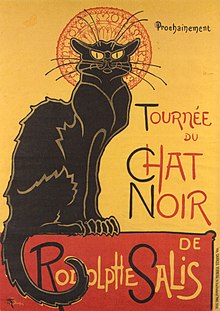Black cat

A black cat is a feline whose fur is uniformly all black, or almost all black. It is not a particular breed of cat and may be mixed or of a specific breed. The all-black pigmentation is equally prevalent in both male and female cats.
Black cats are known for giving good luck, the history of this came from Britain due to their Pagan roots. However in far Western history, black cats have often been looked upon as a symbol of evil omens, specifically being suspected of being the familiars of witches; in other cultures such as Europe and Asia they are also considered to be bad luck.
Black cats have been found to have lower odds of adoption in American shelters compared to other colors (except brown).[1]
Historical associations
Anarcho-Syndicalism
Since the 1880s, the colour black has been associated with anarchism. The black cat, in an alert, fighting stance was later adopted as an anarchist symbol.
More specifically, the black cat—often called the "sab cat" or "sabo-tabby"[2]—is associated with anarcho-syndicalism, a branch of anarchism that focuses on workers' rights. See wildcat strike.
In testimony before the court in a 1918 trial of Industrial Workers of the World leaders, Ralph Chaplin, who is generally credited with creating the IWW's black cat symbol, stated that the black cat "was commonly used by the boys as representing the idea of sabotage. The idea being to frighten the employer by the mention of the name sabotage, or by putting a black cat somewhere around. You know if you saw a black cat go across your path you would think, if you were superstitious, you are going to have a little bad luck. The idea of sabotage is to use a little black cat on the boss."[3]
Black cats in culture
Bohemian culture

Théophile Steinlen's advertisement for the tour of the Chat Noir cabaret
Le Chat Noir (French for "The Black Cat") was a 19th-century cabaret in the Montmartre district of Paris. It was opened on 18 November 1881 at 84 Boulevard Rouchechouart by the artist Rodolphe Salis, and closed in 1897.[citation needed]
Literature
- The Black Cat is an 1843 short story by American author Edgar Allan Poe.
- In the 2002 children's novel Coraline by Neil Gaiman, one of the characters is a black cat who acts as a wise yet snide guide to Coraline. He claims to have an ability to move between worlds at will, and chooses to because the creator of the world he can cross into hates him.
Comics
- Black Cat is a manga series by Kentaro Yabuki.
- Black Cat is a superheroine and occasional supervillainness featured in Marvel Comics.
- Black Cat, a Harvey Comics character.
- El Gato Negro (Spanish for "The Black Cat") is an independent American comic.
- Black cat (film), cat women
Mascot and Characters
- Kutsushita Nyanko is a traveling black cat that wears white socks. "Kutsushita nyanko" is Japanese for "SocksCat". The character was created by San-X.
Confectionery
- Black Cats are a type of jelly confectionery made by Allens. It has been suggested that this is a reference to Edgar Allan Poe's "The Black Cat".
References
This article includes a list of general references, but it lacks sufficient corresponding inline citations. (February 2009) |
- ^ Lepper M, Kass PJ, Hart LA. Prediction of adoption versus euthanasia among dogs and cats in a California animal shelter. Journal of Applied Animal Welfare Science, 2002;5(1):29-42. [1]
- ^ Industrial Workers of the World, An Alphabet Soup: The IWW Union Dictionary
- ^ Red November, Black November: Culture and Community in the Industrial Workers of the World, Salvatore Salerno, 1989, SUNY Press, page 178, from U.S. v. W.D. Haywood, et al., testimony of Ralph Chaplin, July 19, 1918, IWW Collection, Box 112, Folder 7, pp. 7702 & 7711, Labor History Archive, Wayne State University.
- Micklewright, F. H. Amphlett, A Note on the Witch-Familiar in Seventeenth Century England, Folklore, Vol. 58, No. 2 (Jun, 1947) pp. 285–287
- Wedeck, Harry E. A Treasury of Witchcraft: A Sourcebook of the Magic Arts. Avenel, New Jersey: Gramercy Books. 1961.

